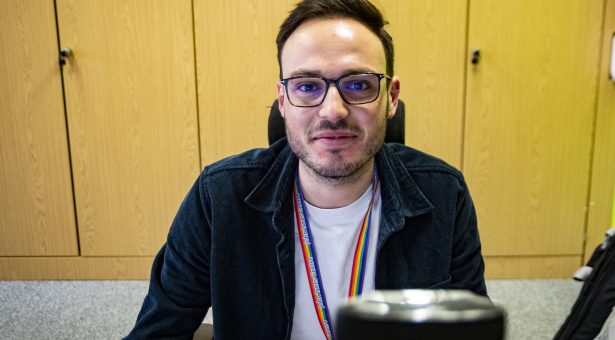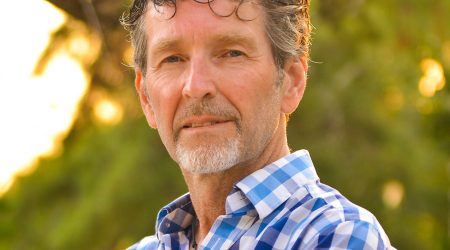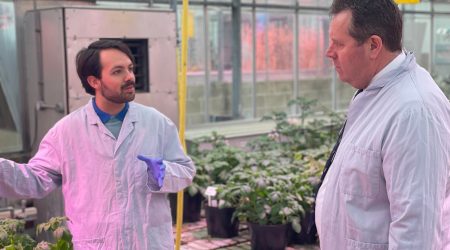Communicating Science; A placement in the Communications team

Earlier this year we hosted Rothamsted PhD student Alex Borg for their Professional Industry Placement (PIPs) in the Communications and Engagement team.
Alex wanted to experience working in science communication and in this blog we hear his experiences from the three-month placement in the team.
“I’m Alex, a third year PhD student who’s just finished a three-month Professional Industry Placement (PIPs) with the Communications and Engagement team here at the John Innes Centre.
Originally from Malta, I’ve been living, working and studying in the UK for five years. My PhD is based in the chemical ecology group at Rothamsted Research in Hertfordshire, working on investigating the mechanisms of aphid resistance in wheat. My project is part of the BBSRC funded Doctoral Training Programme (DTP) scheme and affiliated with the University of Nottingham.
The three-month PIPs are a part of the PhD programme and are designed to give students an opportunity to learn new skills that you otherwise wouldn’t get in your studies. The aim is to help you understand the context of your research in the wider world.
PIPs are also a great way of exploring potential career paths. It is encouraged that the placement is in an area, industry or topic that’s not directly related to your research.
Science communication is often overlooked, but it is an important part of research and academia. Science communicators inform, educate, and raise awareness of scientific discoveries and problems to a wider audience, within and outside of the scientific community.
Before this placement, the only science communications experience I had was from short stints helping the Comms team at Rothamsted where I had been involved with public events. I wanted to know more about what science communication had to offer, so I searched for a PIPs in the field.
I got this placement by directly contacting the team asking if they would be interested in hosting me, and luckily, they said yes.
Following an initial introduction, we collaboratively outlined a plan which involved helping with the day-to-day activities of the team, and a project interviewing and producing new content covering the research of Professor Mark Banfield’s lab.
Before I started, I wasn’t aware of how varied science communication is. In my first few weeks helping with the day-to-day I realised how much variety there is.
My activities ranged from media visits including from BBC Radio 4’s Farming Today and ITV News, carrying out public engagement events like handing out flyers, helping with illustration student visits, managing social media, building internal newsletters, and running events for both staff and students.
I enjoyed this variety. The nature of the role and the team means no day or week was ever the same, keeping the work exciting and meeting a wide range of interesting people from different backgrounds.
A big chunk of my work involved writing articles for internal news, external news and blog posts. This was something new to me. The team gave me a crash course in blog writing and interviewing researchers, and I got stuck in.
Different to the scientific style of writing I’m used to for my PhD, it was a breath of fresh air to write articles for a more general audience and in a more conversational writing style, in the case of blog posts.
These articles covered research from across the John Innes Centre so I quickly got familiar with the basics of a lot of the interesting research across the institute. I also got a chance to do a bit of filming and photography which was a great opportunity to learn some new skills, some of this ended up being featured in the Wall Street Journal’s video covering the purple tomato.
Part of my placement involved working with Professor Mark Banfield and his team to produce a range of articles covering his group. To do this I interviewed Mark and two other members of his team: Postdoctoral Researchers Dr Adam Bentham and PhD student Caroline Stone.
The aim of this project was to showcase their work on plant-pathogen interactions and highlight their different career paths and journey through academia.
As my own PhD project is in a different field to Mark’s research, it was fascinating learning about another area of plant biology. As part of this coverage, I drafted new webpages that explain the Banfield group’s research, and produced a draft animation , something totally new to me.
Possibly playing into the stereotypes of a millennial , one aspect I really enjoyed about the placement was helping with the social media of the John Innes Centre. I drafted and scheduled posts across Facebook, Twitter, LinkedIn and Instagram for different articles and blog posts. This culminated with an Instagram takeover in my last week of the placement. I found it intriguing to see all the stats behind the social media posts, how audiences engage online through these platforms and how social media is used by a research institute.
I’ve learnt more out of the placement than I ever thought I would. It’s been an enjoyable and unforgettable experience, meeting some amazing people and learning about some cutting-edge science being carried out here at the John Innes Centre and across the Norwich Research Park.
The skills I’ve learnt have been invaluable and will help with my PhD and future career, whatever that may be.
I would highly recommend a PIPs in science communications if it’s something that interests and is possible for you. My advice is to get in touch with the Communications and Engagement team at any research institute or university as they are likely to be delighted that you got in touch.”
This blog was written by Alex Borg, while he was on a Professional Industry Placement (PIPs) in the John Innes Centre’s Communications and Engagement Team. Alex is a BBSRC funded Doctoral Training Programme (DTP) student, affiliated with the University of Nottingham.



